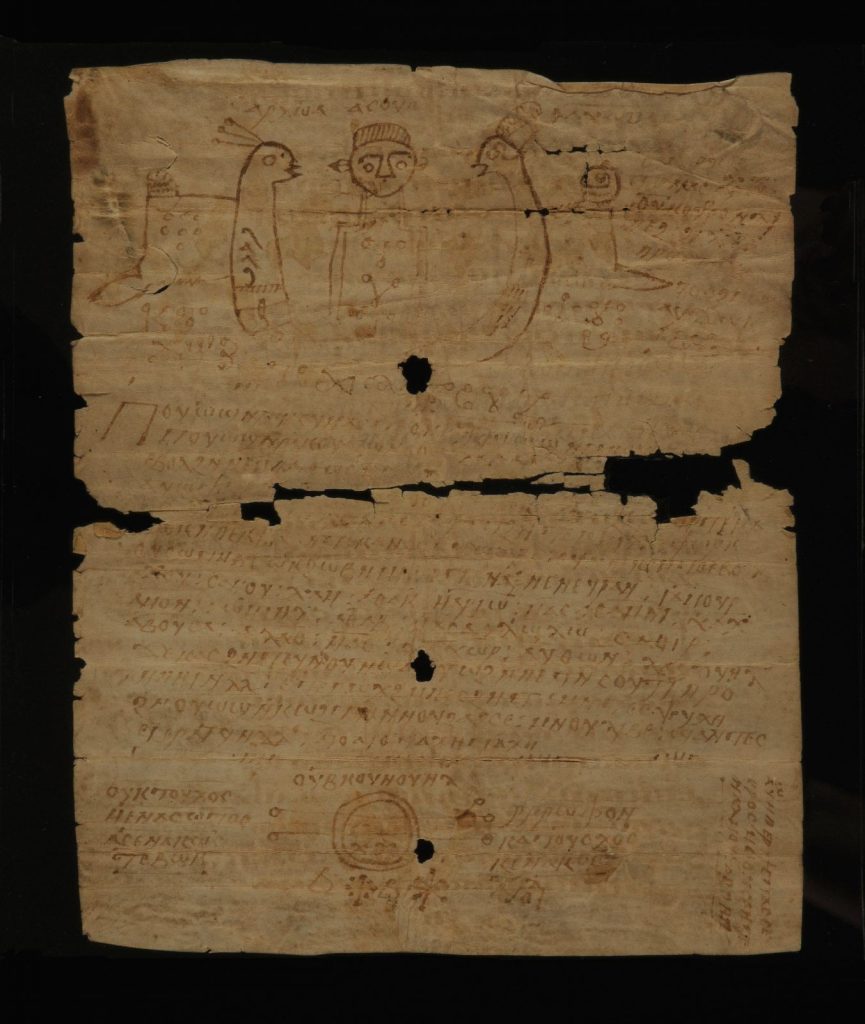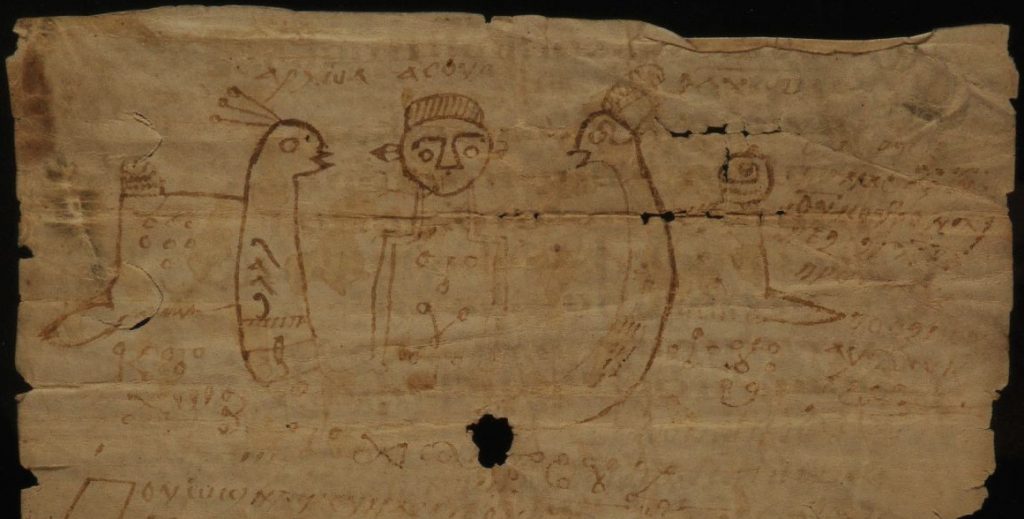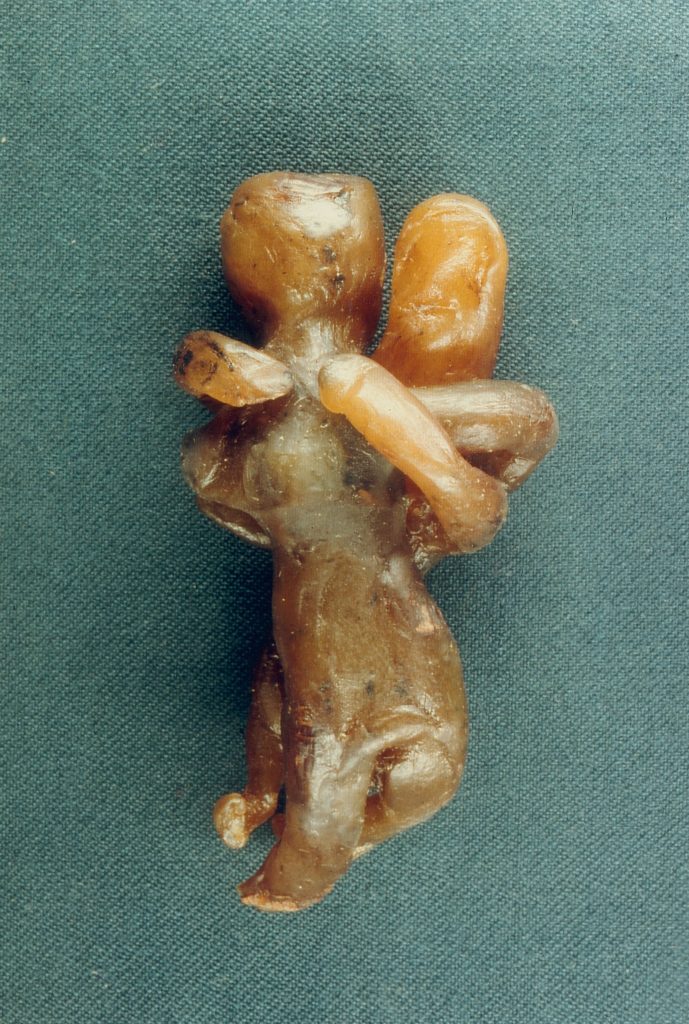This week’s post is the first in a mini-series about the manuscript Leiden F 1964/4.14. Although this manuscript is only one sheet of parchment, it is a formulary containing a series of recipes, ranging from curses to destroy individuals and separate couples, to those intended to reconcile couples or induce sexual desire. Dating paleographically to the 11th century CE, this formulary is among the latest preserved witnesses to Coptic magic. Edited by Michael Green in 1987, the recipes of this formulary were not included in the collection “Ancient Christian Magic” edited by Marvin Meyer and Richard Smith, and so they are not very well known. As one of the many manuscripts we are rediscovering as part of our ongoing work, this relatively neglected text seemed an ideal candidate to bring to a wider audience.
This single sheet, measuring 23.5cm by 19.1cm, is well preserved, with only a small amount of damage. It is a palimpsest, written on top of a literary text – perhaps a hagiography or biblical text, based on similar manuscripts – which has been washed away to make space for the later text. Perhaps as many as 9 horizontal creases run across the width of the parchment, indicating that the sheet was either folded vertically, or rolled and then subsequently squashed. As this parchment is a formulary, containing the recipes that a practitioner would have referred to when carrying out magical practices, it is not surprising to think that it would have been folded/rolled for storage, and then taken out when the practitioner wanted to consult the recipes. Unfortunately, though, this manuscript does not have a provenance; we do not know where it might have come from.

© Rijksmuseum van Oudheden [source]
While the verso (back) of the sheet contains 11 recipes, the recto (front) is covered by one single recipe, complete with a tableau of magical figures, as well as various kharaktēres (magical signs). This composition begins with that substantial tableau, which takes up around a third of the entire sheet. Project member Korshi Dosoo published a study of similar images in 2018 in which he argued that this type of tableau is indicative of love spells. Consisting of two birdlike figures facing a human figure who stands between them, it seems to be a visual representation of a ritual practice which is best attested in the 10th century Arabic text called the Picatrix, but which has parallels going back to 3rd century CE Egypt, associated with spells for either love or hatred. The practice would consist of manipulating two figures representing the targets of a spell – either miniature human figures, or dead birds – who would be made to face one another to cause love, or turned back to back to cause a couple to hate one another. The figures would then typically be buried in a jar, sometimes with a nail stuck through them to keep them in place, and to symbolise the force being ritually applied to them. In the two-dimensional representations of this practice, the same basic principles are followed – two human or bird figures face each other in love spells, or are drawn facing away from each other in separation spells, while a third figure, representing the practitioner, is often depicted beside or between them. Since these figures face one another, we would expect this to be a love spell, and in fact this is indeed the case.

To the right of the top tableau, a series of ritual instructions are written: “Procedure: Write it (with) (wine (?) of the) first fruits on a bone. Offering: Apple-hued henna, and frankincense. (Place it at) the door of the house when the moon is full. It is complete.” The relevance of these instructions will become clear once we have read the invocation that follows.

the tableau’s motif in 3D [source]
The invocation then follows, taking up around one half of the entire sheet:
“The desire… I adjure … you (s.) by the (?) decans … which is in your (s.) hand! I adjure you (s.) by your (s.) 21 decans, the mighty ones who are in your presence, obeying you (s.) (in) everything, whose names are these:
Iaiiour, Ajou, Samou, Kham, Athak, Marmō, Mas, Samni, Khakh, Amoni, Ōmiēl, Athab, Masa, Lōlō, Sathēr, Abousa, Alath, Math, Lakhōr, Authōn, Lakhouēl,
so that as soon as I place your (pl.) image (by) the door of the house of so-and-so, you (pl.) will burn to her heart and her soul, in burning desire and suffering (?), and frenzy until she comes to the feet of so-and-so! Yea, yea, quickly, quickly!”
The beginning mentions the purpose of the ritual – “desire” – but the following part is difficult to make sense of; on closer reading, Green’s initial translation seems incorrect. In the following section, the speaker adjures the addressed power by 21 beings called decans. Originally, the decans were 36 stars or constellations in the Egyptian system of astronomy, going back at least as far as the Old Kingdom. They were later absorbed into the system of Graeco-Egyptian astrology which developed during the Ptolemaic period, coming to refer to smaller divisions of the zodiac; each zodiacal sign had three decans. The importance of the decans in both Egyptian and Graeco-Egyptian astrology led to them becoming an important part of many Mediterranean traditions, including Egyptian Christianity, in which the decans may appear in texts as both star-spirits and as the beings who separate the soul from the body at death, i.e. these 21 “mighty ones” are named one by one, and then commanded to burn the heart and soul of the victim. This burning is further characterised as a suffering and a frenzy, so that “she” – the default target of the practice – is compelled to come to the client.
“Burning” in erotic magical practices is usually interpreted by scholars, such as Christopher Faraone (1999: 43-47), as representing the feeling of violent love and desire. David Martinez (2001) goes further, describing a love spell of this type as representing a kind of “transference” of symptoms – the client who would use the love spell would be suffering from lovesickness, and they would want to make the victim suffer likewise. There are also other interpretations: Edward Love (2016: §5.2) has recently argued that such threats of “burning” are instead the coercion that ensures that the target comes to the client. That is to say, unless (as the text says, “until”) the target comes to the client, the target will suffer “burning”. That being said, this “burning” could also be understood as a metaphor for the passion that is to be instilled in the target of such erotic magical practices for their clients.
Either way, the “mighty ones” are called upon to burn the victim when their “image” is placed at the door of the victim’s house. This makes the connection to the instructions above clear: the image is to be copied onto a bone using wine as ink, and then buried by the door of the house of the target when the moon is full. At the same time, perhaps while the image is being copied and the invocation is being read out loud, the practitioner is to make a burnt offering of henna (specifically, apple-coloured henna) and frankincense. In order for the correct person to be targeted by the practice, the target’s name is then to be entered into the invocation where “so-and-so” stands in the translation, which will then ensure that they are imbued with the “burning desire” for a different “so-and-so”, the client who would have commissioned the ritual. This follows exactly the typical form of a Coptic magical ritual, described in an earlier post.

© Rijksmuseum van Oudheden [source]
A second tableau takes up the remainder of the sheet, centering around a double circle with horizontal lines passing through it, which then end in smaller circles. To the left, above, and right of this form, seven further magical names are provided, and underneath this form the letter beta (ⲃ) alternates twice with an eight-pointed star – common to such collections of signs (kharaktēres). The names read as follows: Ouktoukhos, Menasōtos, Asenakōs, Tsbkōk, Oubkounouēl, Rrrōphon, Katouokos, Kenakōs.
At a right-angle to the bottom tableau, a little advertisement formula is added, reassuring anyone who might worry that, even after carrying out this complicated ritual and burying a bone at their beloved’s house, they might not get what they want. It reads: “Do not doubt it verily, it is good!.”
As described above, this recipe is the first of a series of recipes upon this single sheet, and so subsequent posts will consider the other recipes written upon the verso (back) in order to build up a picture of the structure of the formulary itself, and the series of recipes that one 11th century practitioner had to hand in order to separate and reconcile, curse and arouse, the clients and targets of his magical texts.
Bibliography
Dosoo, Korshi. “Zōdion and Praxis. An Illustrated Coptic Magical Papyrus in the Macquarie University Collection.” Journal of Coptic Studies 20 (2018): 11–22. URL
Faraone, Christopher A. Ancient Greek Love Magic. Cambridge, Massachusetts: Harvard University Press, 1999.
Green, Michael. “A Late Coptic Magical Text from the Collection of the Rijksmuseum van Oudheden, Leiden.” Oudheidkundige Mededelingen uit het Rijksmuseum van Oudheden te Leiden 67 (1987): 29-43.
Green, Michael. “Additional notes on the Coptic Magical Text Leiden F 1964/4.14.” Oudheidkundige Mededelingen uit het Rijksmuseum van Oudheden te Leiden 68 (1988): 113-115.
Love, Edward O. D. Code-Switching with the Gods: The Bilingual (Old Coptic-Greek) Spells of PGM IV (P. Bibliothèque nationale supplement Grec. 574) and their Linguistic, Religious, and Socio-cultural Context in Late Roman Egypt. Berlin: De Gruyter, 2016. URL
Martinez, D. G. “‘May she neither eat nor drink;: Love Magic and Vows of Abstinence.” In Ancient Magic and Ritual Power, edited by Marvin Meyer and Paul Mirecki. Leiden: Brill, 1995, 335–359. URL

3 Comments
Mike Grondin
If there were 36 decans altogether, what distinguishes the 21 “mighty ones”? (I am particularly interested in the number 21 in Egyptian lore since it’s the number of letters in each of the three lines of the logical structure of the Prologue to the Egyptian Coptic Gospel of Thomas.)
Korshi
Hi Mike, thank you for your very interesting question. It’s not clear to me that the author or copyist of this text understands “decan” in its original sense, as one of the 36 asterisms and their associated deities. My impression is that they probably represent here a vaguer type of supernatural being (perhaps with specific links to death), and “mighty” is used simply to describe their nature, rather than to distinguish them from other less mighty decans; “mighty” is often used of decans, angels and other beings in magical texts of this type.
I’m also unsure about the significance of the number 21; obviously it’s probably related to its factors, 3 and 7, which were both already important numbers in magic (and esoteric speculation more generally) in the ancient Mediterranean). Sorry to offer such an unsatisfactory response – perhaps more study will give us a better understanding of these details!
[user]
What a wonderful and a straight forward spell caster that has brought back joy and happiness into my life!!! Am giving this testimony because am so happy, I want to thank [REDACTED] for the great thing He has done in my life , He brought happiness back to my life, I never believed in spell casters until my life fell apart when my lover decided to call it. I was so emotional breakdown to the extent i could not do anything reasonable again, after 2months in pain before an old friend of mine introduced me to a spell caster on line called [REDACTED], this was after I have been scammed by various fake spell casters. I was introduced to [REDACTED] a true Spell Caster. In less than 24 hours i saw wonders, my lover came back to me and my life got back just like a completed puzzle, it was just like a dream to because i thought i had lost her forever. Thank you [REDACTED] for helping me but most of all, Your Honesty and Fast Accurate Results. EMAIL HIM FOR HELP: [REDACTED] or : through his number [REDACTED].